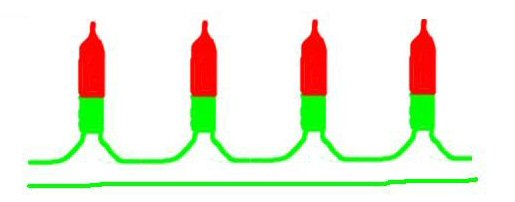Shorten Mini Lights
While Mini-Lights are usually sold in strings of 100, some displays may require strings of less than 100 bulbs. This article will explain how Mini Lights work and how to split them in half.
Please keep in mind this article is not intended to be a technically correct description of a light string, any of its components or electrical usage. This article is intended to give a easily understandable illustration of how a mini light string works.
How Mini Lights Work
The Circuitry
The most common Christmas light string has 100 mini light bulbs and is around 24 feet long. The string is constructed of 2 smaller 50 light sets put together. The 2 50 light sets are put together in a parallel circuit. The 50 light set it self is wired in a series fashion. This is why there are 3 wires in a standard Christmas light string. A hot for the 1st series circuit, a hot for the second series circuit and a common neutral.
A parallel circuit is 2 or more loads wired together in such a way that they both get power all of the time. If one burns out the others keep on burning. This is what allows half a set of lights to go out and the other half stays on. In this wiring scenario each load or bulb must be rated for the voltage it is hooked up to, like a 120v bulb in a light socket. C9 and C7 light strings are wired in a parallel circuit in their entirety.
A series circuit is 2 or more loads wired together in such a way that the electricity goes through the 1st load to get to the second and so on. If the 1st load burns out then they all loose power. This is why when 1 bulb burns out they all go out. In this wiring scheme the voltage, such as 120 volts is shared across every load or bulb in the series. So if we take 120 volts and divide that by the 50 bulbs in the series circuit part of the Christmas light string we get 2.5v each. Well you guessed it, each of the mini light bulbs is rated at 2.5v, in a 50 or 100 bulb string. Remember a 100 bulbs string is nothing more than 2 50 bulb strings put together.
Blown Bulbs and Shunts
In todays modern strings the bulbs have a shunt installed. A shunt is a fancy term for an insulated wire that is wrapped around the leads that hold the filament in the bulb. If the filament is connected and glowing the shunt does nothing. When the filament burns out the shunt then activates, melts the insulation and completes the circuit inside the bulb in place of the filament. This is what allows one bulb to burn out and the others stay lit. Now this condition is only a temporary fix. As stated above the voltage is shared across each bulb in the circuit. When the shunt is activated it acts not like a filament, using electricity, but like a wire only passing electricity. So not that the shunt is in use the voltage across all the loads is 2.5v higher since this bulb is blown. That may not seem like a lot but when you get a few of these burned out bulbs the voltage to be shared across the working bulbs raises exponentially. That is why it is important to replace any blown bulbs as soon as realistically possible. It is better to replace 2 or 3 bulbs than to have to replace an entire string.
Shortening
Cutting
Now that you know how a standard Christmas light string is wired we can shorten one. We need to find the center of the string, between bulb number 50 and 51. Between those two bulbs should only be 2 wires, not 3 like the rest of the string. Once you find the 2 wires between two bulbs you have found the point at which you can shorten the light string. Also there is usually a larger bulb socket at the middle. It is usually the same shape as the socket at the start or the end of the strand. This is the only easily separable point in the string.
Insulating and Adding Plugs
You will need to insulate the cut ends of the 1 series set or add a female plug on it. You will also need to add a male plug to the cut end of the second series set, unless you will not be using it and decide to keep it for spare bulbs or sockets. If you are adding plugs to the cut ends it does not matter which wire is hot or the neutral as there is no polarity.

